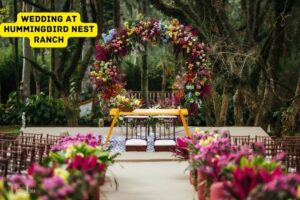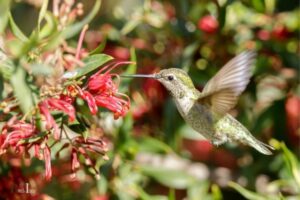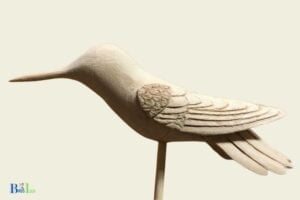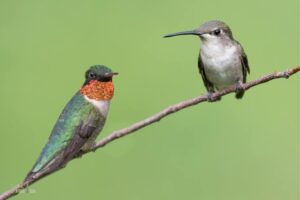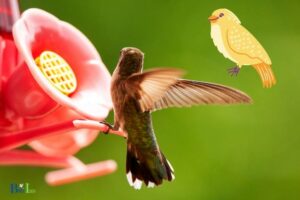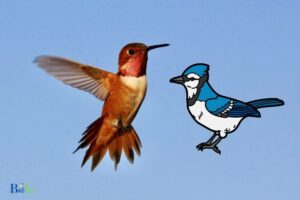How to Plant a Butterfly And Hummingbird Garden: 10 Steps!
To plant a butterfly and hummingbird garden, select a variety of flowering plants that provide nectar and habitat for these pollinators, design the garden layout to optimize their access, and use organic gardening practices to create a healthy environment.
Butterfly and hummingbird gardens are designed to attract and support these beautiful pollinators by providing food, shelter, and nesting opportunities.
By planting a diverse selection of nectar-rich flowers and incorporating habitat features such as water sources and sheltering plants, you can create a vibrant and lively garden that benefits both pollinators and gardeners.
Additionally, offer water sources such as shallow dishes or birdbaths and create shelter by including dense shrubs or tall grasses.
Lastly, utilizing organic gardening practices like avoiding pesticides and using compost for soil amendment helps create a thriving ecosystem for butterflies, hummingbirds, and other beneficial insects.
10 Steps to Plant a Butterfly and Hummingbird Garden
| Step | Butterfly Garden | Hummingbird Garden |
| 1 | Choose a sunny location with at least 6 hours of direct sunlight per day. | Select a sunny spot with some shade, as hummingbirds need a place to rest and cool down. |
| 2 | Research native plants that attract butterflies in your region. | Study native plants that attract hummingbirds in your area. |
| 3 | Plan the layout of the garden, considering the size, shape, and color of the plants. | Design the garden layout, taking into account the size, height, and color of the plants. |
| 4 | Plant host plants for butterfly caterpillars, such as milkweed, parsley, or fennel. | Include nectar-rich flowers with tubular shapes such as trumpet vine, salvia, or fuchsia. |
| 5 | Plant nectar-rich flowers for adult butterflies, such as butterfly bush, coneflower, or zinnia. | Plant flowers in clusters or masses to make it easier for hummingbirds to find and feed from them. |
| 6 | Incorporate plants with different blooming periods to provide a continuous food source for butterflies. | Add plants with varying bloom times to offer a consistent food supply for hummingbirds. |
| 7 | Add flat rocks or stones for butterflies to bask on and warm up their wings. | Provide perches such as small trees, shrubs, or trellises for hummingbirds to rest on. |
| 8 | Provide a shallow water source, such as a birdbath or shallow dish, for butterflies to drink from. | Offer a clean water source for hummingbirds, such as a mister, dripper, or shallow dish. |
| 9 | Avoid using pesticides or herbicides on your butterfly garden, as they can harm butterflies and their caterpillars. | Refrain from using chemicals on your hummingbird garden, as they can be harmful to hummingbirds and their food sources. |
| 10 | Maintain the garden by regularly weeding, watering, and deadheading spent flowers to encourage new blooms. | Keep the garden well-maintained by weeding, watering, and pruning as needed. |
Key Takeaway
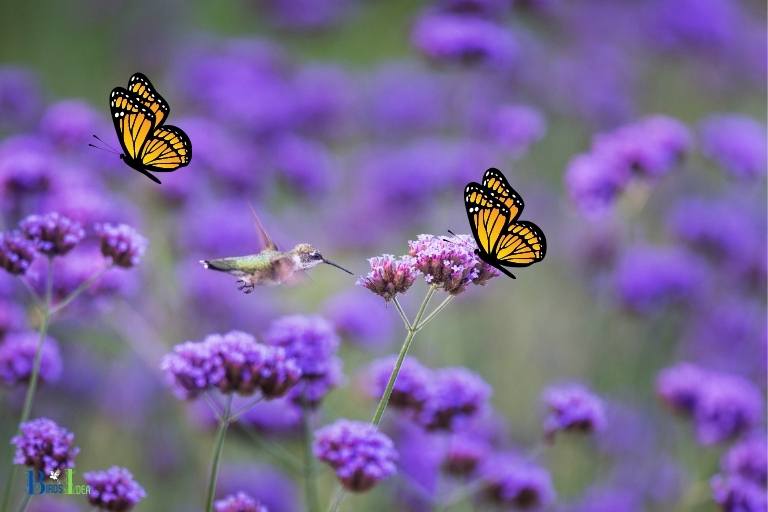
Five Facts About: Butterfly and Hummingbird Gardens
Choosing The Perfect Location
Planning the perfect butterfly and hummingbird garden may take some time, but it all starts with choosing the right location.
Here are some things to consider when deciding on where to plant your garden:
Sun And Shade Requirements For Plants
Different plants have different sun and shade requirements. For example, some plants need full sunlight to thrive, while others require partial or full shade.
It is important to choose a location that matches the amount of sun and shade required by the plants you wish to include in your garden.
Consider the following when deciding on the sun and shade requirements of your garden:
- Identify which plants you want in your garden and research their sun and shade requirements.
- Visit the location at different times of day to determine the amount of sun and shade the area receives.
- Keep in mind that the amount of shade may change over time due to tree growth or other factors.
Shelter From Wind And Predators
Creating a safe haven for your butterfly and hummingbird garden is crucial. You can accomplish this by finding an area that provides shelter from wind and predators.
Consider the following when deciding on shelter for your garden:
- Choose a location that is protected from strong winds, either naturally or man-made.
- Planting shrubs or erecting a fence can provide additional protection from strong winds.
- Look for a location that is less accessible to predators such as cats, dogs, and rodents.
Choosing A Location Near Food And Water Sources
A plentiful food and water supply is vital for attracting and keeping butterflies and hummingbirds in your garden.
Choosing a location with easy access to food and water sources is crucial.
Consider the following when deciding on food and water sources for your garden:
- Choose a location that is near plants that are a food source for butterflies and hummingbirds.
- Consider adding a feeder or bird bath to provide a reliable water source for your garden’s visitors.
- Avoid using pesticides and chemicals in your garden, as it can harm the very creatures you are trying to attract.
Now that you know how to choose the perfect location for your butterfly and hummingbird garden, it’s time to start planning!
With careful consideration of the sun and shade requirements, shelter options, and access to food and water sources, you can create an inviting space for these beautiful creatures to call home.
Happy planting!
Selecting The Plants For Your Garden
Importance Of Selecting The Right Plants
Plant selection is crucial for creating an attractive butterfly and hummingbird garden. Choosing the right plants ensures that your garden will serve as a desirable habitat for these lovely creatures.
Here’s why selecting the right plants is so important:
- The right plants will provide a valuable food source for pollinators, including butterflies and hummingbirds.
- By selecting the right plants, you can create an environment that is both beautiful and functional.
- The right plants can attract a variety of pollinators, which will help to maintain the health and biodiversity of your garden.
Native Plants Vs Exotic Plants
One of the most important decisions you’ll make when selecting plants for your butterfly and hummingbird garden is whether to choose native or exotic species.
Here are some things to consider:
Native plants:
- Native plants generally require less maintenance and water than exotic plants.
- Native plants are well adapted to local growing conditions and soil types, making them more likely to thrive in your garden.
- Native plants provide the best habitat and food sources for native pollinators and other insects.
Exotic plants:
- Exotic plants can add a unique and exotic touch to your garden.
- By choosing exotic plants, you can create a garden that is different from others in your area.
- Exotic plants can be more disease and pest-resistant than native plants.
Best Plants For Butterfly And Hummingbird Gardens
When selecting plants for your butterfly and hummingbird garden, look for plants that are both beautiful and beneficial to pollinators.
Here are some of the best plants to consider:
- Milkweed: This plant is essential for monarch butterflies.
- Butterfly bush: This plant is a favorite of both butterflies and hummingbirds.
- Coneflower: This bright flower blooms for months, attracting a variety of pollinators.
- Salvia: This plant is known for its vibrant colors and ability to attract hummingbirds.
- Lantana: This plant blooms continuously all summer and attracts both butterflies and hummingbirds.
- Verbena: This low growing perennial produces a profusion of blooms and is a favorite of both butterflies and hummingbirds.
- Black-eyed susan: This bright and cheerful flower is a favorite of butterflies.
By selecting the right plants for your butterfly and hummingbird garden, you can create a beautiful and ecologically valuable addition to your yard.
With the right information and a little planning, you can create a garden that will be a haven for pollinators for years to come.
Choosing The Right Soil And Prep
Planting a butterfly and hummingbird garden can be a fun and fulfilling activity. These species are not only beautiful to watch but also play a crucial role in pollination, making them vital for the environment.
However, before you start planting, it’s essential to prepare the soil properly to ensure healthy growth and beautiful blooms.
Here’s what you need to know about choosing the right soil and preparation techniques.
Importance Of Soil Quality
The quality of soil in your garden is a critical factor in the success of your butterfly and hummingbird garden. High-quality soil is essential to provide the necessary nutrients, moisture, and structure to support plant growth.
Here’s what you should keep in mind:
- Soil texture should be loamy. Loamy soil has a balance of sand, silt, and clay and is ideal for plant growth.
- Soil ph should range between 6.0 and 7.0. Slightly acidic soil promotes growth and prevents the accumulation of harmful minerals.
Soil Amendments And Fertilizers
Sometimes, the soil in your garden might not have the necessary organic matter to support plant growth. In such cases, soil amendments and fertilizers come in handy.
Here are some key points to keep in mind:
- Add organic matter such as compost, manure, or leaves to increase the soil’s fertility.
- Apply balanced fertilizers to provide necessary nutrients for plant growth.
- Avoid over-fertilization, which can harm plants and pollute the environment.
How To Properly Prepare Soil For Planting
Proper preparation of the soil is crucial for the success of your garden.
Here’s how you can prepare the soil for planting:
- Remove weeds, rocks, and debris from the planting area.
- Till the soil to a depth of six to eight inches.
- Amend soil with organic matter and fertilizers as necessary.
- Rake the soil to ensure a level planting area.
Planting a butterfly and hummingbird garden entails proper soil preparation to ensure healthy plant growth. By selecting the right soil, amending it as necessary, and preparing it correctly, you can create a beautiful and thriving garden for these incredible species.
Planting Your Garden
Creating a butterfly and hummingbird garden can bring life and vibrancy to your outdoor space. However, proper planning and planting techniques are necessary to ensure optimal growth and attraction for these beautiful creatures.
Here are some helpful guidelines on how to arrange plants, water and maintain your garden and protect from pests and diseases.
How To Arrange Plants For Optimal Growth And Attraction
To attract butterflies and hummingbirds, it is essential to plant a mix of flowers, shrubs, and trees that provide food and shelter.
Follow these tips for arranging your plants:
- Plant in groups: Arrange plants in groups of two to three, which will help attract more butterflies and hummingbirds as they prefer larger clusters of flowers.
- Use a mix of colors: Butterflies and hummingbirds are attracted to bright-colored flowers, mainly those that are red, purple, pink, and yellow, as they can easily identify them from a distance.
- Choose correct plants: Select plants native to your region as this will increase the chances of attracting the local butterfly and hummingbird species.
- Plant in different heights: It is important to create a layered effect in your garden by planting tall flowers in the back, medium ones in between, and short ones in the front.
- Consider flowering season: Plant flowers with different blooming periods, so there is a constant supply of nectar throughout the year.
Watering And Maintenance Tips
Watering and maintaining your garden is crucial to keep it healthy and vibrant.
Follow these tips to ensure proper growth and care:
- Water regularly: Water your garden regularly, especially during hot and dry weather conditions, to keep the soil moist. However, avoid overwatering, as this can lead to root rot.
- Fertilize: Organic fertilizers like compost and well-rotted manure can be used to enrich soil and provide necessary nutrients to your plants.
- Prune regularly: Prune back dead flowers, stems, and leaves to encourage new growth.
- Address pest problems promptly: Inspect your plants frequently for pests like aphids, caterpillars, mites or diseases, and take action, such as using non-toxic insecticides or removing pests by hand.
Protection From Pests And Diseases
Protect your garden from common pests and diseases by taking these preventive measures:
- Choose resistant plants: Select native plants that are resistant to common diseases and pests in your area.
- Monitor regularly: Check your garden frequently for any signs of damage from pests and diseases.
- Clean regularly: Remove dead plant matter, trim back foliage and other debris to limit the hiding places available to pests.
- Rotate plants: Alternate plant species yearly to prevent pests and diseases that can overwinter in the soil.
By following these planting, watering, and maintenance tips and protecting your garden from pests and diseases, you can create a beautiful and thriving butterfly and hummingbird garden that will attract these beautiful creatures.
Attracting Butterflies And Hummingbirds
Butterflies and hummingbirds are some of the most beautiful creatures in nature. They are attracted to colorful flowers, sweet nectar, and other sources of food and water.
By creating a garden that caters to these creatures, you will not only be providing them with a place to thrive but also adding beauty and a sense of tranquility to your surroundings.
Importance Of Creating A Hospitable Environment
Creating a suitable habitat is the first step in attracting butterflies and hummingbirds to your garden.
Here are some guidelines:
- Choose a sunny area – butterflies and hummingbirds love warmth.
- Provide shelter such as bushes and trees for the creatures to rest.
- Ensure access to clean water in a shallow container for the creatures to drink. Additionally, bird baths and fountains offer a great source of entertainment for these creatures.
- Use organic pesticides to avoid harming these creatures or their food sources.
Tips For Providing Food And Water Sources
To attract butterflies and hummingbirds to your garden, you should provide them with a variety of food sources.
Here are some tips:
- Butterflies love nectar-rich flowers such as butterfly bush, coneflowers, and milkweed.
- Hummingbirds enjoy trumpet-shaped flowers such as bee balm and red hot poker.
- Consider providing a sugar solution for hummingbirds as part of their diet.
- Install a feeder for hummingbirds that you can refill with sugar water.
- Create a compost bin in the garden to provide a steady supply of fresh compost for the soil.
Seasonal Considerations For Attracting Butterflies And Hummingbirds
Different butterflies and hummingbirds are attracted to different flowers in different seasons.
Consider these seasonal needs in your garden design:
- In spring, the garden should have early blooming flowers such as lilacs and azaleas to attract early butterflies and hummingbirds.
- In summer, your garden should have a variety of flowering plants that offer a continuous supply of nectar and food for the creatures.
- In fall, choose fall-blooming flowers such as sedum to provide a food source for the migrating butterflies and hummingbirds.
By implementing these tips, providing a hospitable environment and food sources for butterflies and hummingbirds should be easy in your garden. Enjoy the beauty and tranquility, and you’ll be rewarded with a pleasant haven for these wonderful creatures.
FAQ On How To Plant A Butterfly And Hummingbird Garden
What Are The Best Plants For Attracting Butterflies And Hummingbirds?
What Is The Best Time Of Year To Plant A Butterfly And Hummingbird Garden?
How Much Sunlight Do Butterfly And Hummingbird Gardens Need?
How Do You Create A Butterfly And Hummingbird-Friendly Environment?
Where Is The Best Place To Plant A Butterfly And Hummingbird Garden?
Conclusion
Creating a butterfly and hummingbird garden is an excellent way to give back to nature and beautify your yard at the same time. By following the steps outlined in this article, you can plan and plant a garden that will thrum with life as it attracts beautiful and important pollinators.
Remember to choose the right plants for your area, group them appropriately, and provide fresh water, shelter, and food for your visitors.
Keep these tips in mind and be patient – a thriving butterfly and hummingbird garden may take time to develop, but the reward of watching these creatures flutter and buzz about is well worth the effort.
So why not give it a try? Make your garden a haven for these important creatures and enjoy the beautiful and serene outdoor space that you’ve created.

